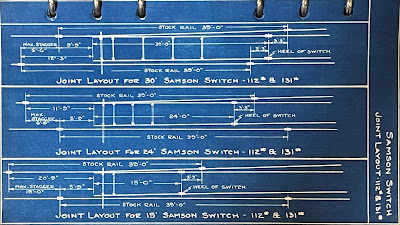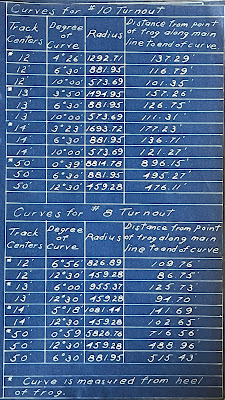While at work I get the chance to do a lot of rail fanning. That is, I get to study the rail and track.
Along Savin St. is a switch for a side track, currently not in use, but still called the Roger Sherman switch/track for a former industry. I will be (semi) handlaying a turnout soon, and also installing the two turnouts for the bulk tracks. So I decided to take some reference photos to prepare for the project.
It's a left-hand switch, and there are many things we can document and learn. To start, there are two throwbars (actually, one spreader bar and one throwbar if my terminology is correct).This is consistent with what I've seen in photos on the New Haven.
While I could file points down in a similar manner, Proto87 Stores sells them ready to go. I don't bother replacing the Microengineering ones, but for handlaid track, they are what I use.
Here's a crop of the Jim Karl photo for comparison. To start, the New Haven photo has a joint with four bolts in the center of them. Otherwise basically the same.
The points have the manufacturer as well as 107 NH notated. They were made by Wharton in August, 1958. The 107 refers to the rail size (107 lb, which was the most common NH size), and was cast for the NH. The 15 refers to the switch (points) length in feet.
Most likely the track side track was installed in 1958, but it also highlights how switches might use heavier rail than the track in service. Code 55 switches are hard to come by, but you could use Code 55 track and Code 70 switches for a light branch line like this.
Here's another view, and you can see that the braces were also made by Wharton.
Note that the points themselves are reinforced on both sides, and ground for a tight fit.
You can see how they fit over the base of the rail, and the stock rail is slightly ground down so it "nests" against the stock rail.
The switch stand is the same model I have in my front yard, and is conveniently a close match to one of the ones by Rapido.
It's interesting that there aren't heel blocks. I added them to one of my turnouts, but not having to will save me time.
One interesting detail is a gauge rod for the diverging track. Forming these out of stiff wire (like piano wire) would actually function for handlaid track.
Although I don't have any way to measure it, this is a very sharp diverging track. It turns out there are 9 gauge bars along this short section. Dale said it's a sharp enough radius that they have difficulty getting cars to couple. The couplers will line up, but the pin won't drop. You can also see how worn the inside of the rail is from the flanges.
The rail in this section is still very old 79 lb rail manufactured in 1899. Some sections of rail are dated 1897. But the switch is 107 lb rail, so there are compromise bars at either end.
The manufacturing marks have largely worn off, but you can see 107 NH on one, and 78 on the other. I've been told the NH used 78 lb and CNE used 79 lb, and based on the info in my earlier post there are very minor differences:
Head Width: 2-16/32" vs 2-6/8"Rail Height: 4-3/4" for bothBase Width: 5" vs 4-3/4"
Looking at the frog, it's a manganese rail bound frog. I haven't researched the details, just know what it looks like.
It also conveniently tells us it was manufactured by Racor, is a No. 10 frog for 107 lb rail on the NH. I prefer a cast or model frog to filing your own since it lacks much of the detail. The Microengineering ones look very good. For handlaid I like the Proto87 Stores ones.
The information noted, 15' foot long switch points for a No. 10 switch, matches the data in the book I have. These are in the order they appear in the book.
As a last look at my post on rail codes, for the Cottage Grove Road grade crossing, 131 lb. rail was used. But there isn't a compromise joint bar to go from 78/79 to 131 lb, so a short section of 107 lb rail was used to bridge them. So this picture conveniently has 79 (code 55), 107 (code 70) and 131 (code 83) rail so you can see how they differ in size.

































No comments:
Post a Comment